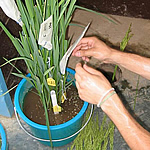Plant Breeding

Ancestral populations of O. rufipogon are predominantly out-crossing, while the sub-populations of O. sativa are predominantly inbreeding (36). This transition from an out-crossing to an in-breeding species is associated with the domestication process and is correlated with a large number of partial sterility factors that reinforce the genetic isolation of the indica and japonica groups (13; 36; 37). These sterility factors make it difficult to generate fertile recombinant offspring from indica X japonica crosses, (13; 40) and help explain why inbred variety development in rice has focused almost exclusively on crosses between members of the same sub-population (indica X indica) or related sub-populations (i.e., tropical japonica x temperate japonica) (25; 35; 40).
In contrast to inbred variety development programs, hybrid rice breeders have utilized a much larger portion of the genetic variability of O. sativa. They have made hundreds of thousands of intra- and inter-sub-population crosses as the basis for identifying productive heterotic combinations (22). Hybrid rice breeding has been very successful in China, but hybrid seed production is still a complex, costly and technology-intensive enterprise. Thus it is difficult to achieve reliable, economically-viable levels of out-crossing for F1 hybrid seed production - due in large part to the enclosed floret morphology and naturally inbreeding habit of O. sativa.
Other ways of exploiting the rich gene pool of natural variation in rice have been explored through embryo rescue and 'wide hybridization', where inter-specific crosses between very distantly related species have been used to introduce important qualitative characters, such as disease resistance or male sterility into elite cultivars (1; 7).
Marker-assisted backcross introgression (45) offers a way to selectively introduce specific traits or components of quantitative trait variation from a wild or exotic gene pool into an elite cultivar with greater efficiency than using phenotypic selection alone. It is used for both inbred and hybrid varietal improvement and has the potential to expand the cultivated gene pool of O. sativa (31).
